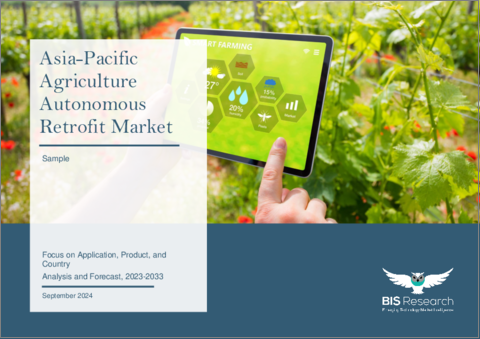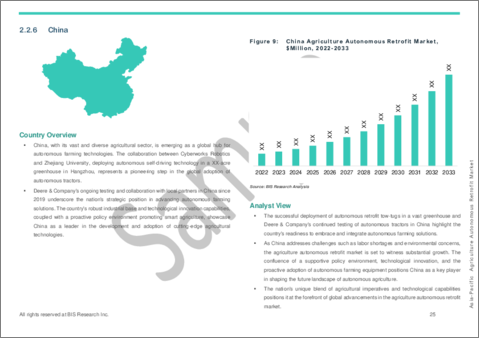|
|
市場調査レポート
商品コード
1565798
アジア太平洋地域のレトロフィット農業自動化技術市場:用途・製品・国別の分析・予測 (2023-2033年)Asia-Pacific Agriculture Autonomous Retrofit Market: Focus on Application, Product, and Country - Analysis and Forecast, 2023-2033 |
||||||
カスタマイズ可能
|
|||||||
| アジア太平洋地域のレトロフィット農業自動化技術市場:用途・製品・国別の分析・予測 (2023-2033年) |
|
出版日: 2024年10月08日
発行: BIS Research
ページ情報: 英文 57 Pages
納期: 1~5営業日
|
全表示
- 概要
- 図表
- 目次
アジア太平洋地域のレトロフィット農業自動化技術の市場規模は、2023年の3億4,680万米ドルから、2033年には18億7,070万米ドルにの規模に成長すると予測されています。
ドライバーレストラクターキット、キャブ内ディスプレイ、スポット散布キット、植え付け自動化キットなどをアジア太平洋地域のレトロフィット農業自動化技術市場は、主要企業の著しい集中を特徴としています。また、最近の戦略的イニシアチブは技術的進歩に重点を置いており、競合と集中が激しいこの地域市場での地位を強化しようとする企業の取り組みが目立っています。
市場イントロダクション
| 主要市場統計 | |
|---|---|
| 予測期間 | 2023-2033年 |
| 2023年評価 | 3億4,680万米ドル |
| 2033年予測 | 18億7,070万米ドル |
| CAGR | 18.35% |
アジア太平洋地域におけるレトロフィット農業自動化技術市場は、生産量と効率を高める独創的な方法に対する農家の欲求の高まりにより、大幅に拡大しています。この業界は、 ドライバーレストラクターキット、キャブ内ディスプレイ、スポット散布キット、植え付け自動化システムなど、さまざまな技術で構成されており、これらはすべて伝統的な農作業を近代化するためのものです。
レトロフィット農業自動化技術は、同地域の農業部門が直面している労働力不足、投入コストの増大、持続可能な慣行への要求に対する実現可能な回答です。こうした進歩のおかげで、農家は作物の総収量を増やし、運営経費を最小限に抑え、資源を最大限に活用することができます。中国、インド、日本、オーストラリアは、農業技術の採用が急増しており、この拡大を推進している重要な国です。
市場の発展は、精密農業やスマート農業を支援する政府プログラムによっても助けられています。同地域市場は、自動化とAIが改善し続ける中で、投資を呼び込み、技術プロバイダー、農業機器の製造業者、農家間の協力を促進すると予想されていす。
市場セグメンテーション
セグメンテーション1:用途別
- 自動トラクター
- 自動実行
セグメンテーション2:製品別
- ドライバーレストラクターキット
- キャブ内ディスプレイ
- スポット散布キット
- 植え付け自動化キット
セグメンテーション3:国別
- 中国
- 日本
- オーストラリア
- その他
当レポートでは、アジア太平洋地域のレトロフィット農業自動化技術の市場を調査し、業界の動向、技術・特許の動向、法規制環境、市場成長促進要因・抑制要因、市場規模の推移・予測、各種区分・主要国別の詳細分析、競合情勢、主要企業のプロファイルなどをまとめています。
目次
エグゼクティブサマリー
第1章 市場
- 動向:現在および将来の影響評価
- 加速する買収取引が農業を変える
- 技術ギャップを埋め、新世代の農業イノベーターを育成
- サプライチェーンの概要
- バリューチェーン分析
- R&Dレビュー
- 特許出願動向(企業別)
- 特許出願動向(国別)
- 規制状況
- 市場力学の概要
- 市場促進要因
- 市場抑制要因
- 市場機会
第2章 地域
- 地域別概要
- 促進要因・抑制要因
- アジア太平洋
- 地域概要
- 市場成長の原動力
- 市場課題
- 用途
- 製品
- 中国
- 日本
- オーストラリア
- その他
第3章 市場:競合ベンチマーキング・企業プロファイル
- 次なるフロンティア
- 地理的評価
- TOPCON CORPORATION
- THORNFIELD
第4章 調査手法
List of Figures
- Figure 1: Asia-Pacific Agriculture Autonomous Retrofit Market (by Application), $Million, 2023, 2026, and 2033
- Figure 2: Asia-Pacific Agriculture Autonomous Retrofit Market (by Product), $Million, 2023, 2026, and 2033
- Figure 3: Key Events
- Figure 4: Supply Chain and Risks within the Supply Chain
- Figure 5: Value Chain Analysis
- Figure 6: Agriculture Autonomous Retrofit Market (by Company), January 2020-January 2024
- Figure 7: Agriculture Autonomous Retrofit Market (by Country), January 2020-January 2024
- Figure 8: Impact Analysis of Market Navigating Factors, 2023-2033
- Figure 9: China Agriculture Autonomous Retrofit Market, $Million, 2022-2033
- Figure 10: China Agriculture Autonomous Retrofit Market (by Application), $Million, 2022, 2026, and 2033
- Figure 11: China Agriculture Autonomous Retrofit Market (by Product), $Million, 2022, 2026, and 2033
- Figure 12: Japan Agriculture Autonomous Retrofit Market, $Million, 2022-2033
- Figure 13: Japan Agriculture Autonomous Retrofit Market (by Application), $Million, 2022, 2026, and 2033
- Figure 14: Japan Agriculture Autonomous Retrofit Market (by Product), $Million, 2022, 2026, and 2033
- Figure 15: Australia Agriculture Autonomous Retrofit Market, $Million, 2022-2033
- Figure 16: Australia Agriculture Autonomous Retrofit Market (by Application), $Million, 2022, 2026, and 2033
- Figure 17: Australia Agriculture Autonomous Retrofit Market (by Product), $Million, 2022, 2026, and 2033
- Figure 18: Rest-of-Asia-Pacific Agriculture Autonomous Retrofit Market, $Million, 2022-2033
- Figure 19: Rest-of-Asia-Pacific Agriculture Autonomous Retrofit Market (by Application), $Million, 2022, 2026, and 2033
- Figure 20: Rest-of-Asia-Pacific Agriculture Autonomous Retrofit Market (by Product), $Million, 2022, 2026, and 2033
- Figure 21: Share of Strategic Initiatives
- Figure 22: Data Triangulation
- Figure 23: Top-Down and Bottom-Up Approach
- Figure 24: Assumptions and Limitations
List of Tables
- Table 1: Market Snapshot
- Table 2: Opportunities across Regions
- Table 3: Agriculture Autonomous Retrofit Market (by Region), $Million, 2022-2033
- Table 4: Asia-Pacific Agriculture Autonomous Retrofit Market (by Application), $Million, 2022-2033
- Table 5: Asia-Pacific Agriculture Autonomous Retrofit Market (by Product), $Million, 2022-2033
- Table 6: China Agriculture Autonomous Retrofit Market (by Application), $Million, 2022-2033
- Table 7: China Agriculture Autonomous Retrofit Market (by Product), $Million, 2022-2033
- Table 8: Japan Agriculture Autonomous Retrofit Market (by Application), $Million, 2022-2033
- Table 9: Japan Agriculture Autonomous Retrofit Market (by Product), $Million, 2022-2033
- Table 10: Australia Agriculture Autonomous Retrofit Market (by Application), $Million, 2022-2033
- Table 11: Australia Agriculture Autonomous Retrofit Market (by Product), $Million, 2022-2033
- Table 12: Rest-of-Asia-Pacific Agriculture Autonomous Retrofit Market (by Application), $Million, 2022-2033
- Table 13: Rest-of-Asia-Pacific Agriculture Autonomous Retrofit Market (by Product), $Million, 2022-2033
- Table 14: Market Share
Introduction to Asia-Pacific Agriculture Autonomous Retrofit Market
The Asia-Pacific agriculture autonomous retrofit market was valued at $346.8 million in 2023 and is expected to reach $1,870.7 million by 2033. The Asia-Pacific agriculture autonomous retrofit market, which includes driverless tractor kits, in-cab displays, spot spraying kits, and planting automation kits, is characterized by a significant concentration of key players. Recent strategic initiatives have focused on technological advancements, highlighting these major players' efforts to strengthen their positions in this competitive and concentrated APAC market.
Market Introduction
| KEY MARKET STATISTICS | |
|---|---|
| Forecast Period | 2023 - 2033 |
| 2023 Evaluation | $346.8 Million |
| 2033 Forecast | $1,870.7 Million |
| CAGR | 18.35% |
The market for autonomous agricultural retrofits in Asia-Pacific (APAC) is expanding significantly due to farmers' growing desire for creative ways to boost output and efficiency. This industry comprises a range of technologies, including driverless tractor kits, in-cab displays, spot spraying kits, and planting automation systems, all meant to modernize traditional farming operations.
Autonomous retrofit technologies are a feasible answer to the workforce scarcity, growing input costs, and demand for sustainable practices facing the APAC agricultural sector. Thanks to these advancements, farmers may increase total crop yields, minimize operating expenses, and make the best use of their resources. China, India, Japan, and Australia are important nations propelling this expansion, as they are experiencing a sharp rise in the adoption of agricultural technologies.
The development of the market is also aided by government programs that assist precision and smart farming. The APAC agriculture autonomous retrofit market is anticipated to draw investments and promote cooperation between technology providers, producers of agricultural equipment, and farmers as automation and artificial intelligence continue to improve.
The APAC agriculture autonomous retrofit market offers tremendous potential for innovation, with a focus on improving sustainability and productivity, ultimately changing the agricultural landscape of the region.
Market Segmentation
Segmentation 1: by Application
- Tractor Autonomy
- Implement Autonomy
Segmentation 2: by Product
- Driverless Tractor Kit
- In-Cab Display
- Spot Spraying Kit
- Planting Automation Kit
Segmentation 3: by Country
- China
- Japan
- Australia
- Rest-of-Asia-Pacific
How can this report add value to an organization?
Product/Innovation Strategy: The product segment helps the reader understand the different applications of Asia-Pacific agriculture autonomous retrofit products. The market is poised for significant expansion with ongoing technological advancements, increased investments, and growing awareness of the use of retrofit kits. Therefore, the autonomous retrofit business is a high-investment and high-revenue generating model.
Growth/Marketing Strategy: The Asia-Pacific agriculture autonomous retrofit market has been growing at a rapid pace. The market offers enormous opportunities for existing and emerging market players. Some of the strategies covered in this segment are mergers and acquisitions, product launches, partnerships and collaborations, business expansions, and investments. The strategies preferred by companies to maintain and strengthen their market position primarily include partnerships and collaborations.
Competitive Strategy: The key players in the Asia-Pacific agriculture autonomous retrofit market analyzed and profiled in the study include manufacturers of agriculture autonomous retrofit kits. Additionally, a comprehensive competitive landscape such as partnerships, agreements, and collaborations are expected to aid the reader in understanding the untapped revenue pockets in the market.
Key Market Players and Competition Synopsis
The companies that are profiled have been selected based on inputs gathered from primary experts and analyzing company coverage, product portfolio, and market penetration.
Some of the prominent names in this market are:
- TOPCON CORPORATION
- THORNFIELD
Table of Contents
Executive Summary
Scope and Definition
1 Markets
- 1.1 Trends: Current and Future Impact Assessment
- 1.1.1 Accelerated Acquisition Deals Transforming Agriculture
- 1.1.2 Bridging the Technology Gap to Empower a New Generation of Farming Innovators
- 1.2 Supply Chain Overview
- 1.2.1 Value Chain Analysis
- 1.3 Research and Development Review
- 1.3.1 Patent Filing Trend (by Company)
- 1.3.2 Patent Filing Trend (by Country)
- 1.4 Regulatory Landscape
- 1.5 Market Dynamics Overview
- 1.5.1 Market Drivers
- 1.5.1.1 Alleviating Farming Labor Shortages with Autonomous Tractor Technology
- 1.5.1.2 Enhancing Crop Yield per Hectare
- 1.5.2 Market Restraints
- 1.5.2.1 Navigating Data Ownership and Privacy Challenges
- 1.5.2.2 Insufficient Legal Framework
- 1.5.3 Market Opportunities
- 1.5.3.1 Growing Demand for Carbon Footprint Cutbacks
- 1.5.3.2 Unlocking Sustainable Solutions for Food Security
- 1.5.1 Market Drivers
2 Regions
- 2.1 Regional Summary
- 2.2 Drivers and Restraints
- 2.3 Asia-Pacific
- 2.3.1 Regional Overview
- 2.3.2 Driving Factors for Market Growth
- 2.3.3 Factors Challenging the Market
- 2.3.4 Application
- 2.3.5 Product
- 2.3.6 China
- 2.3.7 China Agriculture Autonomous Retrofit Market (by Application)
- 2.3.8 China Agriculture Autonomous Retrofit Market (by Product)
- 2.3.9 Japan
- 2.3.10 Japan Agriculture Autonomous Retrofit Market (by Application)
- 2.3.11 Japan Agriculture Autonomous Retrofit Market (by Product)
- 2.3.12 Australia
- 2.3.13 Australia Agriculture Autonomous Retrofit Market (by Application)
- 2.3.14 Australia Agriculture Autonomous Retrofit Market (by Product)
- 2.3.15 Rest-of-Asia-Pacific
- 2.3.16 Rest-of-Asia-Pacific Agriculture Autonomous Retrofit Market (by Application)
- 2.3.17 Rest-of-Asia-Pacific Agriculture Autonomous Retrofit Market (by Product)
3 Markets - Competitive Benchmarking & Company Profiles
- 3.1 Next Frontiers
- 3.2 Geographic Assessment
- 3.2.1 TOPCON CORPORATION
- 3.2.1.1 Overview
- 3.2.1.2 Top Products/Product Portfolio
- 3.2.1.3 Top Competitors
- 3.2.1.4 Target Customers
- 3.2.1.5 Key Personnel
- 3.2.1.6 Analyst View
- 3.2.1.7 Market Share
- 3.2.2 THORNFIELD
- 3.2.2.1 Overview
- 3.2.2.2 Top Products/Product Portfolio
- 3.2.2.3 Top Competitors
- 3.2.2.4 Target Customers
- 3.2.2.5 Analyst View
- 3.2.2.6 Market Share
- 3.2.1 TOPCON CORPORATION
4 Research Methodology
- 4.1 Data Sources
- 4.1.1 Primary Data Sources
- 4.1.2 Secondary Data Sources
- 4.1.3 Data Triangulation
- 4.2 Market Estimation and Forecast






